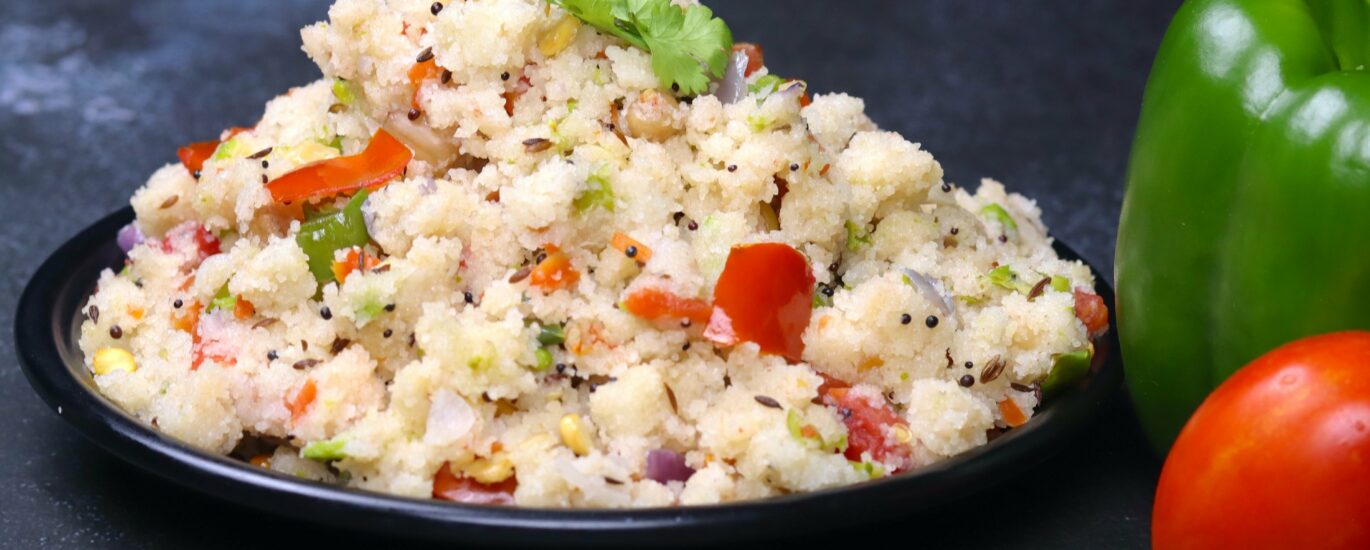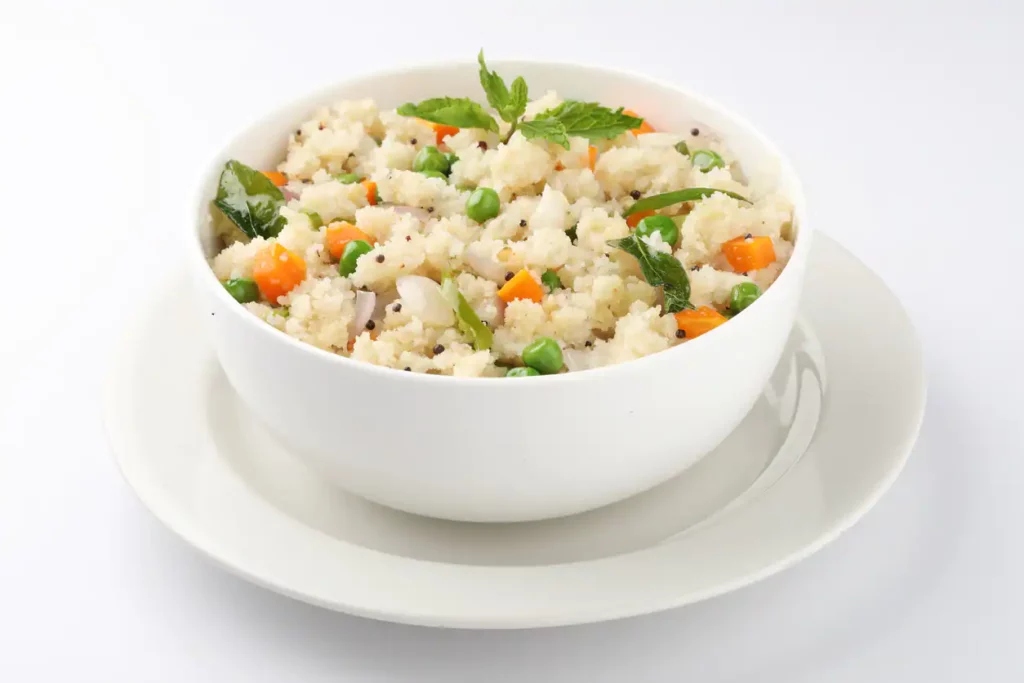

wordpress-seo domain was triggered too early. This is usually an indicator for some code in the plugin or theme running too early. Translations should be loaded at the init action or later. Please see Debugging in WordPress for more information. (This message was added in version 6.7.0.) in /home/sehatnagar.com/public_html/wp-includes/functions.php on line 6114
Upma is a popular breakfast dish in South India, especially in Tamil Nadu, Karnataka, Kerala, and Andhra Pradesh. Upma is a versatile dish and can be customized with different vegetables and spices to suit individual tastes. It is a healthy breakfast option as it is low in calories and high in fiber. Many people in South India love to eat upma. However, many people are also concerned with their weight loss. Such people mostly remain in doubt, weather which dish is suitable for their diet. So, if you are on of them considering weather “Is Upma Good For Weight Loss?”, then this article is for you. In this article, we will provide you all the necessary information related to upma for weight loss.
The most popular part of consuming upma for breakfast is that it keeps you active throughout the day. It is primarily because vegetable upma has fibre-rich, nutritious vegetables. In addition, iron is abundant in upma. Consuming upma is a simple approach to providing your body with iron, a crucial mineral for health.
Upma contains fiber, vitamins, and good fats. It is a nutritious dish that supports a balanced diet. Upma is an excellent option for a weight-loss meal because it digests slowly and makes you feel full. It can be a massive help in your weight-loss efforts.
There are various types of upma that can be made using different ingredients and variations in the cooking method. Some of the most popular types of upma include:
Upma is a healthy and filling breakfast option that can aid in weight loss. It is low in calories and high in fiber, which helps to keep you full for longer and reduces the chances of overeating throughout the day. One cup of cooked upma (150g) contains approximately 220 calories, 2g of fat, 42g of carbohydrates, 2g of fiber, and 6g of protein. The fiber in upma helps to regulate blood sugar levels, which is important for preventing cravings and overeating.
Upma is also a good source of complex carbohydrates, which are slowly digested and provide a sustained source of energy. This is beneficial for weight loss as it helps to prevent cravings and binge eating. Additionally, upma is rich in vitamins and minerals such as vitamin B, iron, and calcium, which are essential for maintaining good health and boosting metabolism.
While upma is a healthy breakfast option, it can be made even healthier for weight loss by following a few simple tips.
Upma can be a good food option for weight loss as it is low in calories and high in fiber. One cup of cooked upma (150g) contains approximately 220 calories, 2g of fat, 42g of carbohydrates, 2g of fiber, and 6g of protein. The high fiber content in upma helps to keep you feeling full for longer periods of time, which can prevent overeating throughout the day and thus lead to weight loss.
However, upma is a complex carbohydrate, which means it is slowly digested and provides a sustained source of energy. This helps to prevent cravings and binge eating, which can contribute to weight gain. Moreover, upma is typically made with vegetables and spices, which can provide additional nutrients and antioxidants to support a healthy diet and weight loss.
Suji/Rava or semolina is abundant in a lot of minerals, including: Suji benefits us in many ways:
Suji upma offers us immense health benefits. Why dietitians recommend upma during diet plan for weight loss because it comes with numerous benefits. Let us know:
1. Zero Cholesterol
Although it is rich in Carbs, suji contains zero cholesterol, making it ideal for frequent consumption.
2. Loaded With Fiber
Also, vegetables added to upma are an excellent source of fiber. So, they make up for the fiber content that is missing in suji. Therefore, upma helps in weight loss. And, raw or semi-cooked onions provide vitamin C in ample amounts. Also, the role of other upma ingredients –
Upma is really easy to make. Let’s read out the steps and try it today.
Ingredients
| Ingredient | Quantity | Ingredient | Quantity |
| Suji/Rava (Semolina) | 1 Cup | Mustard Seeds | 1 Tsp |
| Cumin | 1 Tsp | Olive Oil | 2 Tsp |
| Onion | 1 Medium Sized | Green Chilli | 1-2 |
| Ginger | 1 Tsp (Chopped) | Lemon Juice | 1 Tsp |
| Curry Leaves | 10 – 12 | Haldi (Turmeric) | One Pinch |
| Hing (Asafoetida) | One Pinch | Salt | As Per Taste |

Also, you can replace half of the water used with curd.
Read Also:
Is Chicken Good For Weight Loss? A Guide For Meat Lovers
Is Curd Good For Weight Loss? Dairy Product In Weight Loss Journey
Is Poha Good For Weight Loss – Poha Benefits
Is Corn Good For Weight Loss? Interesting Facts You Should Know
Upma is a healthy breakfast option that can aid in weight loss. It is low in calories, high in fiber, and provides sustained energy, making it an ideal breakfast for weight loss. However, it is important to make upma healthier for weight loss by using whole wheat rava, adding more vegetables, using less oil, and avoiding sugar. By making these simple changes, upma can be included in a healthy diet for weight loss.
Upma is an Indian breakfast meal most popular in Kerala, Telangana, Karnataka, Andhra Pradesh, Tamil Nadu, and Maharashtra. It is a thick porridge made from dry-roasted semolina. However, depending on individual preferences, one uses oats, wheat, quinoa and several other ingredients to make the upma of their choice.
Upma is an excellent choice for weight loss because it digests slowly and helps you feel full. It is a nutrient dense food that contains vitamins and minerals..
Upma is an excellent breakfast option. It only has 86 calories per 100 grams. One serving of upma provides 185 calories.
Upma is a nutritious option for all age groups because it contains proteins, carbohydrates, vitamins, minerals, zinc, phosphorus, and iron. Upma keeps you fuller for a long time. In addition, the nutrients in upma maintain and improve the condition of your kidneys, heart, bones, and immune system.
Yes, eating upma helps you lose weight. You can also choose healthy options like ragi, quinoa, dalia, or oats upma. It has a delicious flavour, is low in calories, and gives you energy. It is suitable for all age groups.
One can make upma in many ways. Using less oil and adding more vegetables make upma more healthy. Oats, rava, ragi, and quinoa are popular ingredients for healthier versions of upma. Also, one can pack more nutrients if one garnishes it with nuts and seeds.
A. Upma is an excellent choice for weight-watchers. It is tasty, low in calories, and provides energy. Eating upma has no adverse consequences. However, portion control should be monitored for weight loss.
Certainly, upma is one of the healthiest options for breakfast. Your go-to breakfast option for weight loss can be upma. Upma contains fibre, vitamins, and good fats. Semolina is used to make upma, and it is high in iron. It is a nutritious dish that supports a balanced diet.
Upma is healthy and delicious. You can eat it every morning for breakfast. Upma is typically a breakfast preparation. However, you can also serve it as a small meal or snack. You can also have upma for dinner. However, restrict the portion if you are trying to reduce your carb intake.
Other delicious breakfast options for losing weight include beetroot dosa, vegetable dalia, besan chilla with green chutney, vegetable poha, paneer bhurji, egg bhurji, oatmeal, and oat poha.
Is Upma Healthy In Diabetes?
Rava upma goes fine with diabetes patients, but when consumed in a controlled portion size. This is because semolina comes under foods that moderately increase the Glycemic Index after consumption.
I Am Gluten-intolerant. Can I have it?
The regular Rava upma is not for the ones that are suffering from Celiac Disease. This is because it has gluten present in it.
Does That Mean I Cannot Eat Upma?
Worry not. We have got you covered. It is not just suji that makes delicious upma. Apart from the suji upma for weight loss, we have several other recipes too. And these can be enjoyed by gluten-allergic persons as well as diabetics.